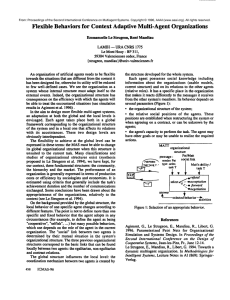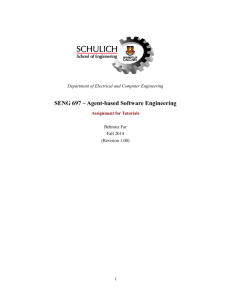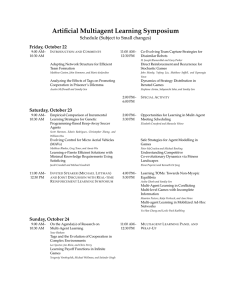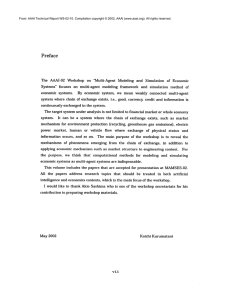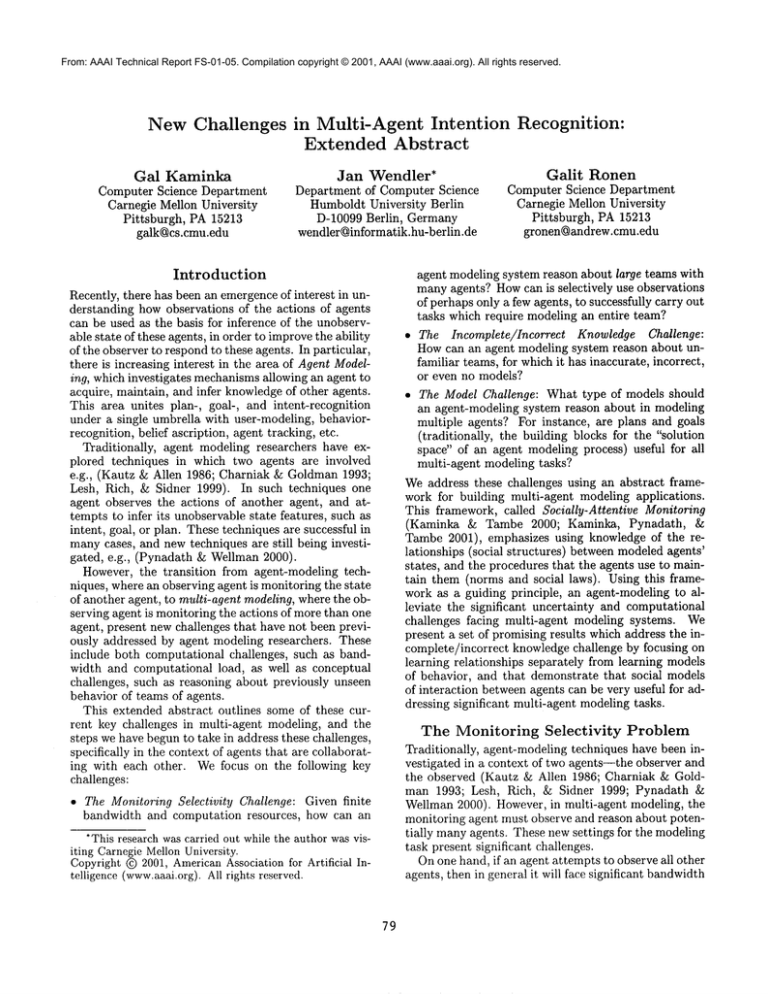
From: AAAI Technical Report FS-01-05. Compilation copyright © 2001, AAAI (www.aaai.org). All rights reserved.
New Challenges
Gal Kaminka
Computer Science Department
Carnegie Mellon University
Pittsburgh, PA 15213
galk@cs.cmu.edu
in Multi-Agent Intention
Extended Abstract
Jan Wendler*
Department of Computer Science
Humboldt University Berlin
D-10099 Berlin, Germany
wendler@informatik.hu-berlin.de
Recognition:
Galit
Ronen
Computer Science Department
Carnegie Mellon University
Pittsburgh, PA 15213
gronen@andrew.cmu.edu
agent modeling system reason about large teams with
manyagents? Howcan is selectively use observations
of perhaps only a few agents, to successfully carry out
tasks which require modeling an entire team?
¯ The Incomplete/Incorrect
Knowledge Challenge:
Howcan an agent modeling system reason about unfamiliar teams, for which it has inaccurate, incorrect,
or even no models?
¯ The Model Challenge: What type of models should
an agent-modeling system reason about in modeling
multiple agents? For instance, are plans and goals
(traditionally, the building blocks for the "solution
space" of an agent modeling process) useful for all
multi-agent modeling tasks?
Introduction
Recently, there has been an emergenceof interest in understanding how observations of the actions of agents
can be used as the basis for inference of the unobservable state of these agents, in order to improvethe ability
of the observer to respond to these agents. In particular,
there is increasing interest in the area of Agent Modeling, which investigates mechanismsallowing an agent to
acquire, maintain, and infer knowledgeof other agents.
This area unites plan-, goal-, and intent-recognition
under a single umbrella with user-modeling, behaviorrecognition, belief ascription, agent tracking, etc.
Traditionally, agent modeling researchers have explored techniques in which two agents are involved
e.g., (Kautz & Allen 1986; Charniak & Goldman1993;
Lesh, Rich, & Sidner 1999). In such techniques one
agent observes the actions of another agent, and attempts to infer its unobservable state features, such as
intent, goal, or plan. These techniques are successful in
manycases, and new techniques are still being investigated, e.g., (Pynadath 8z Wellman2000).
However, the transition from agent-modeling techniques, where an observing agent is monitoring the state
of another agent, to multi-agent modeling, where the observing agent is monitoring the actions of more than one
agent, present new challenges that have not been previously addressed by agent modeling researchers. These
include both computational challenges, such as bandwidth and computational load, as well as conceptual
challenges, such as reasoning about previously unseen
behavior of teams of agents.
This extended abstract outlines some of these current key challenges in multi-agent modeling, and the
steps we have begun to take in address these challenges,
specifically in the context of agents that are collaborating with each other. We focus on the following key
challenges:
Weaddress these challenges using an abstract framework for building multi-agent modeling applications.
This framework, called Socially-Attentive
Monitoring
(Kaminka & Tambe 2000; Kaminka, Pynadath,
Tambe2001), emphasizes using knowledge of the relationships (social structures) between modeled agents’
states, and the procedures that the agents use to maintain them (norms and social laws). Using this framework as a guiding principle, an agent-modeling to alleviate the significant uncertainty and computational
challenges facing multi-agent modeling systems. We
present a set of promising results which address the incomplete/incorrect knowledge challenge by focusing on
learning relationships separately from learning models
of behavior, and that demonstrate that social models
of interaction between agents can be very useful for addressing significant multi-agent modeling tasks.
The Monitoring
Selectivity
Problem
Traditionally, agent-modeling techniques have been investigated in a context of two agents--the observer and
the observed (Kautz & Allen 1986; Charniak & Goldman 1993; Lesh, Rich, & Sidner 1999; Pynadath &
Wellman2000). However, in multi-agent modeling, the
monitoring agent must observe and reason about potentially manyagents. These new settings for the modeling
task present significant challenges.
On one hand, if an agent attempts to observe all other
agents, then in general it will face significant bandwidth
¯ The Monitoring Selectivity Challenge: Given finite
bandwidth and computation resources, how can an
*This research was carried out while the author was visiting CarnegieMellonUniversity.
Copyright (~) 2001, AmericanAssociation for Artificial Intelligence (www.aaai.org).All rights reserved.
79
across the U.S., yet with focused communications between them, the agents are tied in together to function
as a team. Yet due to their distribution, their actions
and state are mostly unobservable to any single human
operator sitting in one of these locations. For instance,
it is difficult for such an operator to view a computer
monitor hundreds of miles away.
and computational difficulties (Jennings 1995). As the
number of agents scales up, bandwidth requirements
grow: For instance, the agent would need to observe all
other agents continuously, which is in general not always possible, as agents becomephysically and logically
separated from each other. In addition, computational
requirements grow: If a monitoring agent is busy modeling all others, a significant computational task (Kautz
& Allen 1986; Pynadath & Wellman 2000), it may run
the risk of not having enough computational resources
available to carry out its other tasks: After all, multiagent modeling is a perceptual sub-task in service of
an overall task for the monitoring agent, such as adversarial planning, coordination, visualization, failure
detection, etc.
Thus the designer of a multi-agent system often
builds the system such that there is some selectivity in
observing and monitoring others. However, if the designer ventures too far, or if the environment physically
constrains the design in such ways, the observing agent
may find it self with insufficient observations, providing only partial information about the state of observed
agents. Thus the observing agent will have uncertainty
about the state of the monitored agents, which may
hinder the observing agent from carrying out its tasks,
such as coordinating with the other agents, planning
interactions with them, etc.
The key challenge, which we refer to as as the Monitoring Selectivity Problem,is thus to identify, for a given
task (a) how much modeling of other agents is necessary to carry out the task; and (b) techniques that will
be able to carry out such modeling, overcoming uncertainty and computational burdens. Over recent years,
we have been investigating modeling algorithms that
provide concrete answers to these two questions in several complex, dynamic, multi-agent domains.
The techniques we investigate are guided by sociallyattentive monitoring, a guiding principle which emphasizes using a model of the expected relationships
between monitored agents’ states to complement reasoning about any other previously-known application/agent models (Kaminka & Tambe 2000; Kaminka,
Pynadath, & Tambe 2001). We focus in this extended
abstract on utilizing knowledgeof collaborative relationships between team-mates in service of different modeling tasks. Agents in a team are dependent upon each
other, and their important state features, such as beliefs about the world, plans, and goals, will therefore
be dependent as well. These dependencies can be identified by the designer, by collaboration engines (e.g.,
GRATE*(Jennings 1995), COLLAGEN
(Rich & Sidner 1997), etc.), or by theory (Grosz &Kraus 1996).
Consider the following example, following (Kaminka,
Pynadath, & Tambe 2001), that demonstrates multiagent modeling with and without the use of knowledge
of a particular collaborative relationship amongagents:
In this example, a set of heterogenous agents is integrated into a distributed application (team) to run
the Internet. Different agents are running on machines
To solve this problem, a multi-agent intentionrecognition system was built to provide real-time visualization of the state of each agent. In theory, the
system could have relied on report-based monitoring, in
which each agent continuously updates the visualization
system as to the agent’s state. However, such a solution does not scale very well, since it requires modifying
agents to send these reports (a problem with legacy and
proprietary systems), and it adds significant costs to
the computational and bandwidth requirements, since
agents must devote some of their resources to generating and transmitting these reports.
Wetherefore proposed to visualize the state of the
agents based on their routine communications, used as
observations by a multi-agent modeling system. The
initial solution attempted to model each agent independently of its peers, by utilizing an array of probabilistic plan-recognizers, in which each observed agent
was modeled separately. But due to the scarcity of observations (agents communicateroutinely only once per
20 state changes, on average--and some don’t communicate at all), this approach proved unsatisfactory, resulting in 3-4% average accuracy in actual system runs
(Kaminka, Pynadath, & Tambe 2001).
To address this difficult challenge, we focused on
social knowledge (please see (Kaminka, Pynadath,
Tambe2001) for details). First, although in the initial solution each agent was modeled independently, in
reality agents were expected to be dependent on each
other: They were supposed to switch together from one
abstract modeof operation to the next (as part of any
such abstract modeeach agent would carry out different action). Thus agents were supposed to be in agreement as to the mode the team is in. Agreement on
the joint plan to be executed by team-membersis indeed commonin teamwork applications (Jennings 1995;
Tambe1997). Second, the routine communications between agents during task execution were somewhatpredictable, and in fact such predictions were amenable
to learning. By eliminating modeling hypotheses that
did not conformto the agreement relationship (i.e., hypotheses where agents were not in agreement), or did
not conform to the predicted communications(i.e., hypotheses where agents switched mode without sending
a predicted message), the accuracy of visualization was
increased to 84% on average (up to 97% in some experiments). Furthermore, by restricting the modeling
algorithm to only these hypotheses, we were able to
realize computational space and time savings of about
90%.
8O
The Knowledge
Challenge
One of the key assumptions typically made in planrecognition, user-modeling, and other agent modeling
investigations is that the set of possible explanations
for the observations is knowna-priori in the form of
a plan-library, i.e., the recognition problem is cast as
a set membership query (Kautz & Allen 1986). However, as agent modeling techniques are being applied
in multi-agent systems, this assumption is often problematic. For instance, in building a coach agent for
RoboCupsoccer games (Noda et al. 1998)--one of our
current projects--one cannot assume that the behavior
of opponent soccer teams will be explained correctly by
an existing plan-library.
Weare tackling this challenge by trying to reason separately about a task’s plan-library, i.e., the set of recipes
associated with carrying out a particular task (possibly
by multiple agents), and the social plan-library, i.e., the
set of relationships maintained and procedures used by
the same agents as part of their task execution. Our
hope is that this separation will yield not only computational benefits, but will also allow a designer to
correctly characterize the nature of the incompleteness
or incorrectness of the plan-library in question, for a
given multi-agent modeling task.
Weare investigating this problem in the context of
two projects. The first projects deals with building
multi-application assistant agents (in which the relationships are unknown),the second with building a soccer coach for the RoboCupsoccer simulation environment (in which the task knowledge is unknown). Here,
we focus on the multi-application assistant project.
The vision of the intelligent assistant agent has been
explored in manydifferent investigations, and of course
is now finding commercial applications (for instance,
as the Microsoft Office assistant).
However, the traditional focus of such applications were on assisting a
single user in the context of a particular application being used. For instance, the Microsoft Office assistant is
able to provide detailed help about writing letters in
Word, or equations in Excel. The usefulness of engaging in user-modeling for such collaborations between an
application and a user has also been demonstrated in
(Lesh, Rich, & Sidner 1999).
However, a user does not always use a single application in service of carrying out a single task. Consider a typical Java or Python development scenario.
Muchof the power of developing in these two different
computer languages lies in their large, useful, standard
libraries. As a result, a typical developer often finds
herself switching back and forth between the program~
ming editor (e.g., Emacs) used for writing code, and
an online documentation browsing tool (e.g., Netscape)
used to explore the depths of the online documentation
for the standard library.
A traditional assistant approach would conceptually
have an Emacs-assistant actively trying to help the user
edit the program, and a Netscape-assistant helping the
user browse the web-page. These two conceptual as-
81
sistants would each see the user being active for a few
minutes, then becoming inactive (in the context of the
specific application) for a few minutes more, only to
becomeactive again later on, and so on. What is conceptually missing here is not detailed knowledgeabout
what each application is capable of doing, or howa user
uses each single application.
Instead, the missing knowledgeis concerned with how
a developer uses and coordinates these two applications
together to accomplish a single task--writing code effectively. A better intelligent assistant would need to
recognize such relationships and utilize them to provide
better assistance (for instance, by predicting needed
web-pages based on code being written). However, it
is difficult to predict all the possible relationships that
can occur between applications: After all, there are indeed many different possible tasks that a user may be
carrying out, and enumerating all possible application
combinations is not a practical approach.
Weare therefore attempting to learn to recognize
very general patterns of such dynamic interactions
based on past observations of the user interacting with
multiple applications. The key idea is to assume that
all interactions between applications are equally-likely,
and then recognize statistically significant patterns that
emerge where the user interacting with one application
is correlated with future interactions of the user with
another application. To do this, we are currently adopting the Multi-Stream Dependency Detection (MSDD)
algorithm (Oates & Cohen 1996) for reasoning about
such observations of complex applications (the algorithm was originally built to reason about simple atomic
observations). Furthermore, we are developing the infrastructure necessary to monitor multiple applications
without modifying them, and this is proving to be a key
technical challenge.
The Model Challenge
A final challenge we address here is the challenge of
finding useful modelsto reason about as part of a multiagent modeling system. Traditionally, plans (sequences
of actions), beliefs, and goals (ending states) are used
the models that an agent-modeling application reasons
about, e.g., (Kautz & Allen 1986; Charniak & Goldman 1993; Pynadath & Wellman 2000). However, the
application of agent-modeling techniques in multi-agent
settings breeds new challenges: For instance, the need
to reason about relationships as first-class modelingobjects.
Consider the following example, which rose in the
soccer coach-building project briefly mentioned above.
One of a coach-agent tasks is to automatically identify
weaknessesin the capabilities of teammates, and to offer
advice to counter such weaknesses. As an example, we
wanted our coach to be able to improve player’s passing
abilities (the players are also software agents interacting with the coach in the RoboCupsoccer simulation).
Naturally, it is relatively easy for the coach to recognize
passes that failed, versus those that succeed. However,
a more difficult challenge is for the coach to rank all
successful passes according to their quality: To do this,
the coach must differentiate not between a failed attempt and a successful pass, but instead between two
successful passes of different qualities.
Weapproached this problem by looking at passes as
an instance of coordinated activity between two agents.
In fact, passing conforms to a very commoncoordination process (Malone & Crowston 1994) composed of
producer (the kicker), who produces and delivers a resource (the ball) to a consumer(the intended receiver),
at the right time and in the right way. Thus the coach
agent does not need to recognize a plan, or a goal, for
the two agents, but instead recognize to what degree
they are engaged in a particular coordination relationship.
Webuilt alternative models of producer-consumer coordination processes which the coach was able to recognize. Such models differed, for instance, in where they
placed the optimal interception point for the receiver
of the ball, the intended velocity vector of the receiver
at the time the ball was to be intercepted, the velocity vector of nearby opponents, etc. However, a key
idea in all of these models was that a perfect coordination conforming to the model would require minimal
effort on the part of the receiver in intercepting the ball,
where such effort is measured in deviation from the intended velocity vector of the receiver. In other words,
a perfectly coordinated pass is one where the receiver
is intercepting the ball exactly where and when it had
intended to go all along, without needing to slow down,
change course, or speed up. Based on these models,
the coach ranks observed passes, in essence specifying
which passes were most closely matched by which models. In other words, the coach is recognizing different
coordination relationships.
To verify our approach, the coach was run on the
recorded games of the RoboCup evaluation sessions
(Kaminka 1998), data from controlled experiments
which dozens of RoboCup teams were run against a
fixed opponent, in an effort to create a scientificallymeaningful data allowing for ranking teams. The results have been encouraging: In both the 1998 and 1999
data sets (dozens of mega-bytes of data, thousands of
simulation cycles), we have found a correlation (on the
order of 0.5) between the ranking of a team in terms of
its pass success-rate (how manypasses are successful),
and conformity with two particular models of coordination that we have developed: In one of these models
the receiver was assumed to intend to continue its velocity vector at the time of the kick, and in the other,
the receiver was assumed to be slowing downto a halt
starting at the the time of the kick. More details are
provided in (Wendler, Kaminka, & Veloso 2001).
cal. However,the transition from traditional intentionrecognition (agent-modeling) settings, where a single
agent is modeling another, to settings where an agent
is modeling many other agents, is raising many difficult challenges to current techniques. In particular,
three of these challenges are the monitoring selectivity
problem, the plan-library incompleteness/incorrectness
challenge, and the model challenge. Weare actively
investigating ways to address these challenges, within
the framework of socially-attentive
monitoring, which
focuses on the social structures and procedures within
the monitored multi-agent system. Wehave provided a
summaryof current preliminary results demonstrating
the usefulness of this approach.
References
Charniak, E., and Goldman, R. P. 1993. A Bayesian
model of plan recognition. Artificial Intelligence
64(1):53-79.
Grosz, B. J., and Kraus, S. 1996. Collaborative
plans for complexgroup actions. Artificial Intelligence
86:269-358.
Jennings, N. R. 1995. Controlling cooperative problem
solving in industrial multi-agent systems using joint
intentions. Artificial Intelligence 75(2):195-240.
Kaminka, G. A., and Tambe, M. 2000. Robust multiagent teams via socially-attentive monitoring. Journal
of Artificial Intelligence Research12:105-147.
Kaminka, G. A.; Pynadath, D. V.; and Tambe, M.
2001. Monitoring deployed agent teams. In Proceedings of the International Conference on Autonomous
Agents.
Kaminka, G. A. 1998. The multi-agent systems evaluation repository, http://www.cs.cmu.edu/~galk/Eval/.
Kautz, H. A., and Allen, J. F. 1986. Generalized plan
recognition. In Proceedings of the National Conference
on Artificial Intelligence, 32-37. AAAIpress.
Lesh, N.; Rich, C.; and Sidner, C. L. 1999. Using
plan recognition in human-computercollaboration. In
Proceedings of the Seventh International Conference
on User Modelling (UM-99).
Malone, T. W., and Crowston, K. 1994. The interdisciplinary study of coordination. A CMComputing
Surveys 26(1):87-119.
Noda, I.; Matsubara, H.; Hiraki, K.; and Frank, I.
1998. Soccer server: A tool for research on muttiagent
systems. Applied Artificial Intelligence 12(2 3):233250.
Oates, T., and Cohen, P. R. 1996. Searching for structure in multiple streams of data. In Proceedings of
the Thirteenth International Conference on Machine
Learning, 346-354.
Pynadath, D. V., and Wellman, M. P. 2000. Probabilistic state-dependent grammarsfor plan recognition. In Proceedings of the Conference on Uncertainty
in Artificial Intelligence, 507-514.
Summary
As multi-agent systems grow in popularity in research
and in actual real-world applications, the role for multiagent modeling techniques becomes increasingly criti-
82
Rich, C., and Sidner, C. L. 1997. COLLAGEN:
When
agents collaborate with people. In Johnson, W. L.,
ed., Proceedings of the International Conference on
Autonomous Agents, 284-291. Marina del Rey, CA:
ACMPress.
Tambe, M. 1997. Towards flexible teamwork. Journal
of Artificial Intelligence Research7:83-124.
Wendler, J.; Kaminka, G. A.; and Veloso, M. 2001.
Automatically improving team cooperation by applying coordination
models. In The AAAI Fall symposium on Intent Inference for Collaborative Tasks.
AAAIPress.

